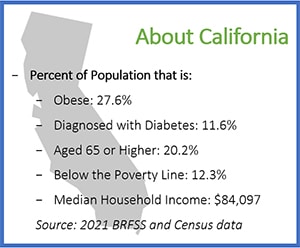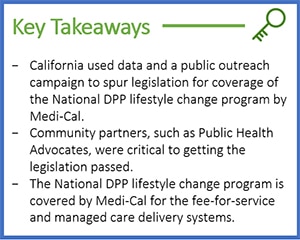Medicaid → State Stories of Medicaid Coverage → California
California’s State Story of Medicaid Coverage
Establishing Coverage
Beginning in 2014, Public Health Advocates (PHA) and a coalition of partners worked with the University of California, Los Angeles (UCLA) Center for Health Policy Research and the Centers for Disease Control and Prevention (CDC) to estimate the prevalence of prediabetes in California. The results, published in early 2016, indicated that in California, more than 13 million adults (46 percent of all adults in the state) are estimated to have prediabetes or undiagnosed diabetes, and 2.5 million adults (9 percent of all adults in the state) have diagnosed diabetes. These startling numbers made front page news (PHA worked with a firm to execute a public relations campaign that led to extensive media coverage), and a national panel of experts made policy recommendations on how California should respond, including the recommendation for coverage of the National Diabetes Prevention Program (National DPP) lifestyle change program by Medi-Cal, California’s Medicaid program.The study also caught the attention of California state legislators, and garnered unprecedented bi-partisan support. Medi-Cal coverage of the National DPP lifestyle change program was championed by Dr. Joaquin Arambula, the Assembly Budget Subcommittee chair, and was unanimously approved in Senate Bill 97. On July 10, 2017, California Governor Jerry Brown signed Senate Bill 97, requiring the Department of Health Care Services (DHCS) to establish the National DPP lifestyle change program within the Medi-Cal fee-for-service (FFS) and managed care delivery systems. About a year later Assembly Bill 1810 changed California’s eligibility requirements for a beneficiary to participate in the National DPP lifestyle change program to align with CDC’s Diabetes Prevention and Recognition Program (DPRP) requirements. To learn more about these bills, see the California example on The Role of the State Legislature in Medicaid Coverage page of the Coverage Toolkit.
To secure federal Medicaid matching funds for the National DPP lifestyle change program, California submitted a State Plan Amendment (SPA) on December 26, 2018. The SPA was approved by CMS on October 24, 2019, with an effective date of January 1, 2019. The SPA created a new provider type to allow CDC-recognized organizations to be reimbursed by Medicaid. More information on when a SPA is needed can be found on the Attaining Federal Medicaid Matching Funds Through a Medicaid State Plan page.
PHA was a critical partner in helping to get the legislation passed, demonstrating the need for additional funding to translate the National DPP lifestyle change program into 17 threshold languages in California (Arabic, Armenian, Cambodian, Chinese, English, Hindi, Farsi, Hmong, Japanese, Korean, Laotian, Punjabi, Russian, Spanish, Tagalog, Thai, and Vietnamese), and launching a prediabetes awareness campaign. They also led a work group of stakeholders who compiled recommendations to influence the design of the benefit within Medi-Cal and to increase access for Medicaid beneficiaries. More on these initiatives are described in the Program Features Unique to California section below.


Implementing Coverage
Medi-Cal began implementing coverage of the National DPP lifestyle change program on January 1, 2019.
Benefit Breakdown
In California, to be eligible to participate in the National DPP lifestyle change program, participants must meet the most current CDC DPRP participant eligibility requirements. Any Medi-Cal provider choosing to offer the National DPP lifestyle change program must obtain CDC-recognition. California’s benefit allows for up to 24 months of participation in the National DPP lifestyle change program. The program typically consists of weekly core sessions during months 1 to 6, monthly core maintenance sessions during months 7 to 12, and ongoing maintenance sessions during months 13 to 24 for participants who achieve or maintain at least 5% weight loss from the first core session and meet attendance requirements. Individuals who have had an unsuccessful attempt at completing the core services period once in the previous five years may participate in the National DPP lifestyle change program again if a medical provider maintains documentation of the medical condition or circumstance that warrants additional participation.
The National DPP lifestyle change program benefit structure differs between the FFS and managed care delivery systems in the following ways (the table below introduced during the February 2019 PDSTAT webinar):
| Characteristics | Fee-for-Service (FFS) | Managed Care Plan (MCP) |
| Patient Population | 2.3 million | 10.8 million |
| Billing and Reimbursement | Medi-Cal DPP providers bill DHCS directly through claims. DHCS will directly reimburse providers per claim. | Medi-Cal DPP providers contract with or make payment arrangements with MCPs. MCPs are directed to maintain documentation of HCPCS codes to show members meeting/not meeting appropriate milestones. |
| Policy Details | See the Medi-Cal DPP coverage and reimbursement policy. California is in the process of finalizing FFS systems and process. The coverage and reimbursement policy is available in the Medi-Cal Provider Manual. | See Medi-Cal’s All Plan Letter. |
| Delivery Methods | In-person and distance learning delivery methods are available. | In-person, distance learning, online, and combination delivery methods are all available. |
| Provider Enrollment | Enroll through the Provider Enrollment Division (PED) at DHCS. See PED’s enrollment and screening bulletins. Providers are encouraged to enroll in Medi-Cal’s Subscription Service for updates at MCSS Subscriber Forms. | Enroll through the Provider Enrollment Division at DHCS (or through MCPs who offer internal enrollment). |
Medicaid-Enrolled Providers
Only Medi-Cal enrolled ‘DPP providers’ may be reimbursed for National DPP lifestyle change program services. CDC-recognized organizations can enroll in Medi-Cal by submitting an application to the DHCS Provider Enrollment Division. To enroll as fee-for-service (FFS) Medi-Cal DPP providers, CDC-recognized organizations must meet current Medi-Cal provider enrollment requirements and standards, as well as have either pending, preliminary, or full recognition through the CDC’s DPRP. More information on Medi-Cal enrollment requirements and procedures is available here. To enroll as managed care Medi-Cal providers, CDC-recognized organizations can enroll through the FFS system or by contacting the managed care plan(s) they are partnering with for more information.
The Medi-Cal Provider Manual states that the following existing Medi-Cal provider types may also enroll to render National DPP lifestyle change program services for both the FFS and the managed care delivery systems. They must receive approval from DHCS and be designated as Medi-Cal DPP providers to be reimbursed for National DPP lifestyle change program services.
- Home Health Agencies (HHA)
- Physicians
- Physician groups
- Indian Health Services/Memorandum of Agreement (IHS/MOA)
- Federally Qualified Health Centers (FQHCs)
- Rural Health Clinics (RHCs)
- Free clinics
- Community clinics
- Multispecialty clinics
- County clinics not associated with hospitals
- Otherwise undesignated clinics
- Community hospitals (outpatient)
- County hospitals (outpatient)
- DPP suppliers
- Home and Community-Based Services (HCBS) nursing facilities
Lifestyle Coaches
Medi-Cal DPP providers may use peer coaches (i.e., lifestyle coaches) to provide National DPP lifestyle change program services to Medi-Cal beneficiaries. These coaches are required to obtain and maintain a valid National Provider Identifier (NPI) at all times. Physicians, non-physician practitioners, or unlicensed persons who are trained to deliver the required CDC curriculum and have the skills, knowledge and qualities specified in the National DPP standards can serve as peer coaches. Medi-Cal DPP providers must submit and maintain a roster of all peer coaches, which includes each coach’s full name, NPI number, birth date, and Social Security Number.
Unlicensed peer coaches must have an arrangement with a Medi-Cal DPP provider in order to receive reimbursement for rendering National DPP lifestyle change program services to Medi-Cal beneficiaries.
Reimbursement, Coding, and Billing
Medi-Cal’s HCPCS codes are intended to track a National DPP lifestyle change program participant’s progress. These codes provide useful data to providers, program members, and state agencies. Medi-Cal reimburses in both the FFS and the managed care delivery systems as described below. For a Medi-Cal eligible participant in the National DPP lifestyle change program that attends all the sessions for the two-year program and attains all the weight loss goals, the CDC-recognized organization would receive a total reimbursement of $536.
CDC-recognized organizations planning to bill Medi-Cal for reimbursement can find the required process for enrollment and reimbursement outlined in the Guide for Diabetes Prevention Providers New to Medi-Cal.
- Core Sessions Months 1-6:
- (G9873) 1st session attended – $20
- (G9874) 4 sessions attended – $40
- (G9875) 9 sessions attended – $72
- Core Maintenance with 5% weight loss:
- (G9878) 2 sessions attended in months 7-9 – $48
- (G9879) 2 sessions attended in months 10-12 – $48
- Core Maintenance without 5% weight loss:
- (G9876) 2 sessions attended in months 7-9 – $12
- (G9877) 2 sessions attended in months 10-12 – $12
- Ongoing Maintenance Months 13-24 (maintained 5% weight loss and attended 2 sessions every 3 months):
- (G9882) Months 13-15 – $40
- (G9883) Months 16-18 – $40
- (G9884) Months 19-21 – $40
- (G9885) Months 22-24 – $40
- Weight Loss Performance:
- (G9880) achieved 5% weight loss OR had absolute reduction of waist circumference by 3.2 cm during months 1-12 – $128
- (G9881) achieved 9% weight loss during months 1-24 – $20
- Bridge Payment transitioning from a different DPP provider:
- (G9890) Months 1-24 for first DPP core session, core maintenance session, or ongoing maintenance session – $20
Program Features Unique to California
Size
There were approximately 13.3 million people enrolled in Medi-Cal as of January 2018, about one-third of California’s population, which means a large network of CDC-recognized organizations is needed to administer the National DPP lifestyle change program to eligible Medicaid beneficiaries. Some solutions that work in smaller states are not feasible in California and vice versa. The size of the state also increases the variety in California’s demographic and population needs.
California’s Barrier Analysis
California conducted a barrier analysis in the process of planning for Medicaid coverage of the National DPP lifestyle change program. This barrier analysis was an in-depth look at potential challenges California might face during implementation of the program. Most notably, the analysis identified perceived barriers for CDC-recognized organizations and MCPs, including:
- Perceived barriers for CDC-recognized organizations
- Lack of knowledge of the Medi-Cal National DPP lifestyle change program benefit
- Background check/fingerprint requirements
- Low reimbursement rates
- Invoice system infrastructure
- Perceived barriers for MCPs
- Questions about the All Plan Letter (policy guidance for MCPs)
- How MCPs can offer benefit internally by achieving CDC-recognition
- Concerns around audits and investigations
- Low reimbursement rates
Diabetes Awareness and Outreach Campaign
California is implementing a large diabetes awareness and outreach campaign (anticipated in the summer of 2020) with goals to increase awareness among Californians at risk for type 2 diabetes, address the link between type 2 diabetes and cardiovascular disease, and drive eligible individuals to the National DPP lifestyle change program. The campaign incorporates radio, digital, cable, and outdoor ads, and focuses on populations where prediabetes risk is the highest. An advisory committee aids the campaign development. This campaign is led by the California Department of Public Health (CDPH) and has a legislated $2.5 million budget.
Lessons Learned
One challenge California faced was the specific, detailed language used in the legislation that limited flexibility in implementing the benefit. The benefit was modeled after Medicare’s DPP (MDPP) benefit, which was meant to reduce confusion and administrative burden for plans and providers.
Another challenge was calculating a budget through the capitated rate for MCP reimbursement. The benefit uses performance-based codes and it was unclear what the utilization of the benefit would be. DHCS used population trends to create a budget projection estimate for the National DPP lifestyle change program for the California legislature. Please note that California’s estimate was not based on utilization data and did not reflect managed care costs.
Additional Resources
General State Resources about the Medi-Cal DPP Benefit
- Medi-Cal DPP Webpage
- DPP Medi-Cal Provider Manual
- Questions about Medi-Cals’ DPP benefit: DHCSDPP@dhcs.ca.gov
Medicaid Enrolled Provider Information
- Guide for Diabetes Prevention Providers New to Medi-Cal
- Updated Medi-Cal Enrollment Requirements and Procedures for Diabetes Prevention Program
- Questions about Medi-Cal enrollment through Provider Enrollment Division (PED): PEDCORR@hdcs.ca.gov









